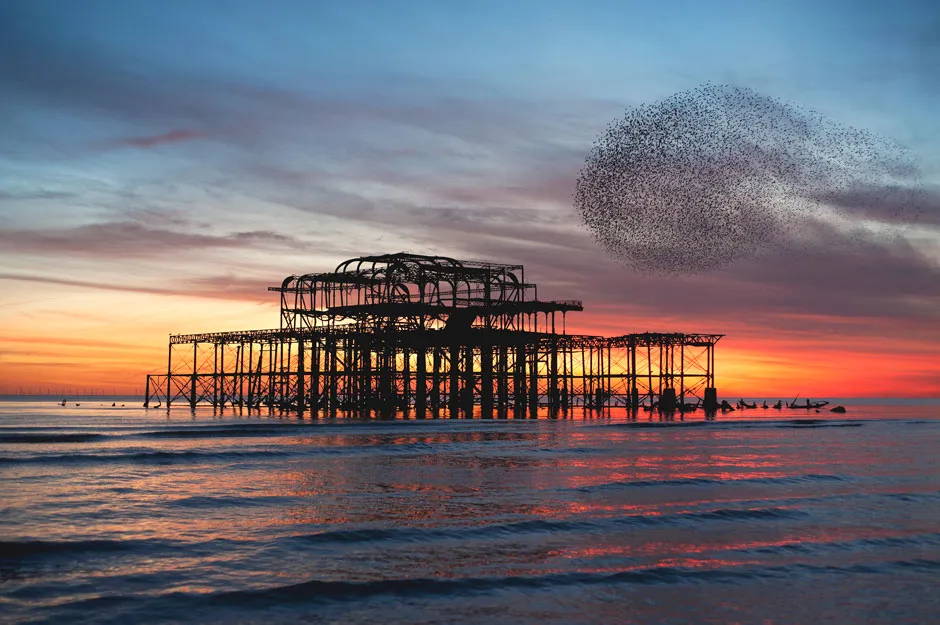Starlings have got serious style. Not only can they lay blue eggs, recognise each other from their chirps alone, but the short-tailed birds can also put on an aerial display to rival the Red Arrows.
Known as starling murmurations (due to the sound produced by the multiple wingbeats involved), this sky dance sees flocks gather together, swooping and twisting across the sky in one spectacular swarm.
Consisting of at least 500 starlings, these formations have been known to feature up to a million birds in the UK. And this number can be much higher overseas: up to five million of them have been known to gather in Rome.
But why exactly do starling murmurations happen? Why don’t the birds collide with one another? And, most importantly, where can you see them in the UK? You can find all your answers flocked below.
Why do starling murmurations happen?
Despite a phenomenon that humans have witnessed over many thousands of years, we don’t yet have one definitive explanation for starling murmurations.
However, there are two leading theories as to why the birds could flock together this way:
- To protect themselves from predators.
- To keep warm at night.
Let’s take the top idea first: how could an aerial ballet possibly protect starlings from predators such as sparrowhawks and buzzards?
“Firstly, if you’re a starling and part of a large flock, you reduce your chances of becoming dinner through what we call the ‘dilution effect’,” explains Prof Anne Goodenough from the University of Gloucestershire.
“It’s a numbers game: you’re less likely to be the bird targeted by predators in a crowd. Plus, as the entire flock effectively has more eyes to spot any predators, there’s also increase vigilance.”
Read more about the science of birds:
But while these ideas explain why the birds gather in such large groups, it doesn’t effectively spell out why they form a series of unpredictable 3D shapes in the sky. This is why experts think starlings murmurate to turn any predator’s laser-focus vision against them.
“Birds of prey tend to hunt by getting ‘focus lock’ on one individual starling and attacking them –they don’t just fly into a flock with their talons out and hope for the best. However, when starlings put on this intricate display, it’s much harder for predators to launch at one bird. Attacking an entire flock would be like trying to juggle with soot,” Goodenough says.
But how could murmurations provide a flock warmth? Well, it’s not the aerial display itself that generates heat. Instead, some zoologists have argued that as the sky dance happens just before roosting, it could simply be a signal for birds to gather ahead of a cold night ahead.
“In this way, the murmuration events might effectively be advertisements for the roost site – it's much warmer for an individual starling to be roosting as part of a big flock, rather than on its own or part of a small flock,” explains Goodenough.
However, the theory that starlings gather to protecting themselves from plummeting temperatures isn’t the easiest to swallow. As Goodenough’s own study of 3,000 murmurations has shown, there’s little correlation between temperature and the size of the displays. This indicates starling swarms are primarily an anti-predator adaptation.
Why don’t starlings hit each other in a murmuration?
In a crowd of a few hundred tightly-packed runners, you’d expect to knock into somebody occasionally, right? Then how do a few million starlings manage to keep their distance from each other during a murmuration?
In short, it’s because the birds have incredibly good social-distancing instincts. “They all keep space from one another with their incredible vision and reactions that are faster than our elite athletes,” explains Goodenough.
“Visually, starlings are really good at being able to understand what's happening around them – and they also have strong motor responses to adjust to it.”
Of course, in the middle of million birds, each starling isn’t aware of everyone else in the murmuration. However, 3D reconstructions indicate that every bird interacts with – and moves according to – its nearest six or seven neighbours.
Read more about animal gatherings:
Where can you see a starling murmuration in the UK?

As starling murmurations occur just before roosting, you’re most likely to see one by a large tree or artificial structure like a pier. Derbyshire’s Middleton Moor, Somerset’s Ham Wall and Belfast’s Albert Bridge are among the many spots to host murmurations each year (see the Starling murmuration map for more UK locations).
“However, you can also find their murmurations occurring in areas where you don't expect them,” says Goodenough. “For instance, I’ve seen murmurations of about 10,000 birds in the middle of Cheltenham town centre! Sometimes you can get lucky.”
Murmurations can often happen between October and March – but they peak around the beginning of November until the end of January. “Particularly for birds that roost in artificial structures such as piers – think Brighton or Aberystwyth – you can also get a display every single night in this period – typically for around 30 minutes,” says Goodenough.
“I’d advise anyone to see this amazing phenomenon – you never get the same display twice, even at the same location. It’s almost like music: you have this series of notes that can form to create a different melody each time.”
About our expert – Prof Anne Goodenough
Anne Goodenough is a Professor of Applied Ecology at the University of Gloucestershire. Her research interests span from nesting ecology of birds to ecological impact assessment, mammal conservation and the role of citizen sciences in studying biology and ecology. Goodenough also heads the annual UK #StarlingSurvey to record murmurations.
Read more about the science of birds: